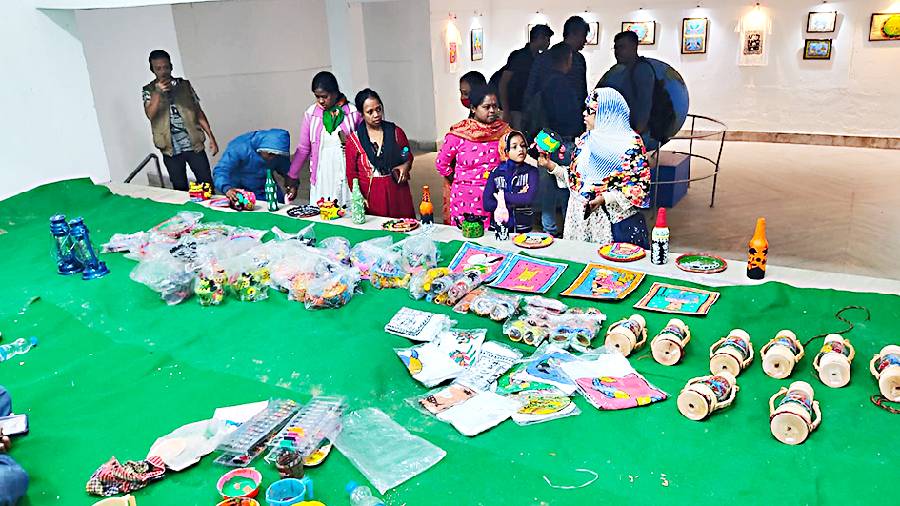An exhibition that generated income for local women through the revival of a long-lost folk art just ended in the Sunderbans.
The month-long exhibition, held inside the Sajnekhali Wildlife Sanctuary, sold paintings, postcards, kettles, lanterns and T-shirts, all inspired from the Sunderbans patachitra (scroll painting) and made by a team of local women.
Seven finalists were selected out of a pool of 40 women who underwent a four-month training — led by Chinmoy Mukhopadhyay, a contemporary artist and illustrator focussed on Bengal folk art — that culminated in the exhibition. The training and exhibition were funded by the Sunderban Tiger Reserve (STR).
The sale of the items raised over Rs 1,50,000, said organisers. Around a third of the amount has been kept aside to buy raw materials for the next lot of items to be made by the women. The remaining has been distributed among them. The team comprised seven members, meaning each of them received around Rs 15,000.
The modest amount assumes a much larger scale when pitted against the daily livelihood struggles of these families in one of the most inhospitable terrains of the world. To be able to learn something new and earn money out of it is an unfamiliar feeling for all of them.
Most of their husbands risk their lives to hunt for crabs in the shallow creeks, constantly in fear of tiger and crocodile attacks. Some work as masons, some as labourers outside Bengal. The sector is unorganised and no work usually means no pay.
Surma Khatun Bairagi, 23, one of the seven finalists, has kept the amount in the bank. The family’s savings is inching towards the amount needed for building a pucca house, said Bairagi, whose husband is a mason who is now in Chennai for work.
They live in a mud house with a thatched roof, which suffered back-to-back damages in cyclones Amphan (2020) and Yaas (2021).
Bairagi often took her two-and-a-half-year-old son to the training at Pakhiralay of STR.
Another woman from her village, Madhushree Das, was also among the seven. She wants to keep some of the amount to enrol her three-year-old daughter in a primary school and give the rest to her husband, a fisherman who wants to buy a battery-driven three-wheeler.
“Money is very important. But also important is the recognition. Before the training, I had never touched a brush. Alpona was the only painting I could do. I never thought I could learn painting and earn money out of it,” said Das.
Some of the women had to travel for close to two hours to reach the camp.
The organisers were upbeat after the exhibition.
“Since the exhibition was held in the peak tourist season, the footfall was decent. The women have rekindled interest in a lost art form and created a possible source of a sustainable livelihood. Considering the absolute lack of formal training, their achievement is doubly special,” said Sourav Mukherjee of the Kolkata Society for Cultural Heritage, the NGO that trained the women and is now supporting them in marketing the products.
Bookmarks, postcards, coasters, bags, T-shirts, kettles, clay pots, cups — the exhibition featured a lot of items. A bookmark cost Rs 10 and a T-shirt Rs 350. The women helmed the stalls.
An STR official said the project would be scaled up in the coming days. A souvenir store run by STR in Sajnekhali will get a facelift and sell the items, he said.
“The store receives a footfall of around 3,00,o000 annually. We are also planning to sell these products through other stores run by the forest department in the Sunderbans. Online sales and an exhibition in Kolkata are on the cards too,” said Justin Jones, deputy field director of STR.
